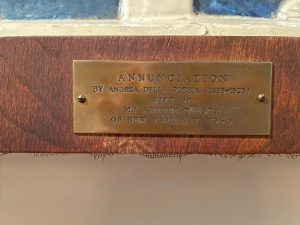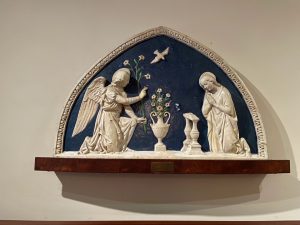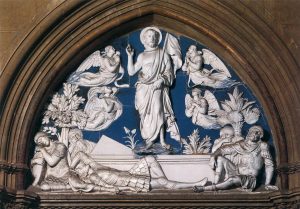The following is a selection from Catholic University student Moira McCoy’s class paper on Andrea della Robbia’s Annunciation, a piece of Renaissance-era Italian art held by Special Collections at the University. Ms. McCoy’s piece was submitted as an assignment for Professor Tiffany Hunt’s course ART 272: The Cosmopolitan Renaissance and edited by Special Collection’s Dr. Maria Mazzenga. The students used art from the University collections for their papers.
***
Andrea della Robbia’s Annunciation is a prime example of the movement of Renaissance art from the late fifteenth century into the present-day world. This terracotta relief sculpture, currently displayed at The Catholic University of America, has very little documentation prior to its donation to the University in 1960 by Mr. Arthur T. Roth. This piece was created for a Florentine audience, but we might ask how the message of this art piece changed throughout time and location.

The Annunciation’s archival file in Special Collections offers a foundation for research. Though Robbia’s Annunciation is not extremely well documented, readers do get a general idea of the artist, the donor, and other aspects through the file. There is no signature of the artist that tells us for certain that this is an original Andrea della Robbia, though the metal plaque on the bottom of the sculpture is associated with the Florentine sculptor (Figure 1). This sculpture has little known transaction prior to its donation to the University in 1960. There appears to be no documentation of how Roth, a prominent New York banker, purchased the Robbia sculpture, indicating that the piece may have itself been a gift to him.
Along with the file is information about the artist, Andrea della Robbia. His role as a sculptor under the influence of his uncle, Luca, lead us to understand that the Florentine artist’s pieces were to attract the local audience. Personal research shows that there is very little evidence of Robbia pieces in the western world today, indicating that they were primarily meant for the Italian viewers of the fifteenth century. There is no confirmed date of completion of Andrea’s Annunciation, nor is there information on this specific piece on public online sources. When viewing the object file, the date of execution is vaguely indicated as “fifteenth century (?).” Of the pieces in Florence today, there is a highly designated purpose that these pieces fulfill. Andrea della Robbia appears to be a sculptor of religious scenes primarily, as most pieces are in correlation with religious institutions. Many of these pieces remained in Florence due to the sculpture type, as they are attached to their original space, and removal would be difficult.

The Annunciation appears to the viewer in a semi-circular arch with a peaked top, (Figure 2). At first glance, viewers may find this piece to have little detail due to the dominating white-blue color tones of the sculpture. The deep, muted blue provides a background to the whitened figures of Mary and Gabriel, as well as other features such as the dove, flowers and vase. This blue background is also the deepest layer of the relief whereas the white objects and figures appear in the higher relief layer. But why use these two tones as the main colors of the piece? It is believed that the cerulean blue and ivory white color scheme is a trademark of the Robbia workshop founded by Luca della Robbia, Andrea’s uncle. These colors are functional and unique colors which mark all pieces from the Robbia. In other pieces, such as Luca della Robbia’s Resurrection (Figure 3), we are sampling the earlier model of this blue-white glazing technique that is constant in all Robbia works, including a brighter green to the work for forestry and brightness. A secondary claim as to why these colors are utilized is in the remembrance of the Florentine aesthetic of the Renaissance. The memory of Florentine Renaissance leaves us with the idea of Humanism and the imagery of the Florence artists’ personal touch. Nineteenth-century essayist Walter Pater wrote on Luca della Robbia’s use of blue and white terracottas, stating that “…nothing brings the real air of a Tuscan town so vividly to mind as those pieces of pale blue and white earthenware . . . like fragments of the milky sky itself, fallen into the cool streets, and breaking into the darkened churches..” (1) which reinforces the statement that the use of these duochromatic palettes in the Robbia art space are reminiscent of the Florentine art style and appeal to the fifteenth century audience. The last claim is the significance of the subjects, and the importance of these colors in a religious sense. Though there is a paragraph on the religiosity of the scene ahead, it is important for researchers to understand how the light blue is seen in many different versions of the Annunciation pieces, from Northern territory artists such as van Eyck to the Italian Fra Angelico. The blue is often associated with Virgin Mary whereas the white is to symbolize the purity of the Annunciation scene, with iconography of white lilies and a dove. Overall, it is important to note that something as simple as the color palette connects to the location of Florence, the iconography of religious symbols and figures to the individualism of the artist.

A major feature of Andrea della Robbia’s artwork and style is his material use and glazing techniques. Terracotta is a form of clay-based material that is fired under extreme heat to solidify into a ceramic texture. This clay is found in many parts of the world, such as Asia, the Mediterranean & Africa, and is used in pieces from sculptures to brick making. Its application in Renaissance art was popularized by Ghiberti and Donatello during the early fifteenth century (2). Terracotta was used for two main reasons. First, the Mediterranean region where it existed was accessible to Florentine artists. Second, the clay material was easily pliable for artists of the era. The soft shape of the material allowed artists to decorate and create free flowing shapes very different from metals, marble, and other resources. Andrea was introduced to the making of terracotta sculpture while an apprentice to his uncle Luca. Luca’s innovation of developing glazed and colored terracotta that, when fired with glazes, would fuse with the clay underneath and result in brightness and shine. Furthermore, Andrea’s improvement in the creation of these enameled figures was to leave the face, hands and other parts bare. The emphasis of polychrome, or multiple colors, on Andrea’s pieces gives the Florentine artist a sense of individuality within the della Robbia workshop.
Andrea della Robbia’s Annunciation was made as a religious motif that includes all of the classical iconography of the biblical scene of the Annunciation of Mary with Gabriel. The event takes place when Gabriel the Angel descends to the Virgin Mary and announces that she will bear the child of the Holy Spirit, reiterated in the Book of Luke. The Holy Spirit is symbolized by a dove or rays of light in these scenes whereas the inclusion of white lilies is the symbol of the Virgin Mary, indicating her purity. Specifically in Andrea’s Annunciation, we see all four of these characters. Gabriel and Mary face each other with a vase of lilies filling the space between them. Above head, a swooping dove represents the Holy Spirit. Even if the viewer does not know the name of the art piece, these subjects tell the story of the Annunciation. In the Renaissance eye, the Annunciation scene was popularized to portray the old to new transition through the world, just as the change from the Old to New Testament. More importantly, the Annunciation connects with the Renaissance ideology of a new age of religion and mankind. Appealing to the Franciscan ideals of contemplation upon art, Andrea conceived many of his pieces to the influence of Franciscans in Florence during the Early Renaissance period. Contemplation of art allows the viewer to meditate on the Annunciation scene, which can evoke the reliving of the biblical event to the viewer and give a sensational understanding of the Holy Spirit’s role during the Renaissance era. Furthermore, the role of Gabriel could be the concept of Renaissance, or rebirth, who is appointing new changes upon the Virgin Mary, symbolizing the European society of the times.
The function of this art piece is to appeal to the religious perspective of its audience. Though we do not know the original location of this piece, many parts of this terracotta sculpture tell us that this was made for a religious institution and serve the purpose as a religious piece. Other than the obvious iconographic traits of this piece, the shape also indicates an interesting aspect. The arching shape with the semi-pointed top, known as a tympanum, is noticeably similar to the shape of Luca della Robbia’s piece Resurrection, a terracotta piece that is found above the left sacristy in the Cathedral of Santa Maria del Fiore (Fig. 3). The shape of tympanums have changed drastically through time and with the ideas of reconnecting with the classical Roman features, the shapes of the Andrea and Luca della Robbia pieces act not only as a symbol of Renaissance art, but also gives researchers some insight that Andrea’s Annunciation may have been originally placed or created as a tympana for a religious site or church. What appears as a little detail actually gives lots of context to the religious function.
Andrea della Robbia’s Annunciation allows viewers to gather insight as to how important documentation is for pieces of historical artwork. With the thin file and little to no information on the actual piece itself, the interpretation of the piece relies on the audience members to recognize the iconography and biblical importance of this scene. Being able to comprehend the symbolic message of this terracotta sculpture was a task for this viewer, as it was a noticeably religious scene and would have been reinforced by the original location. The world of Florentine Renaissance highlights the importance of rebirth and return to the humanistic view of antique Greek and Roman society. The Renaissance was a new turning point for Europeans in means of politics, society, literature and philosophies and though that time has passed, the significance of Andrea della Robbia’s Annunciation has not lost its importance, but merely been lost to time and underappreciation for the original Florentine piece.
Sources:
(1) Pater, Walter The Renaissance: Studies in Art and Literature, February 1873. Page 63-72
(2) Victoria and Albert Museum, “Italian Terracotta Sculpture,” Italian Terracotta Sculpture (London September 4, 2013)
